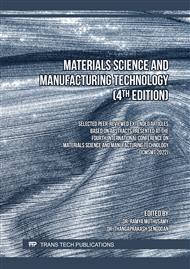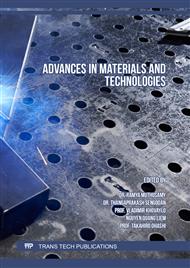[1]
A. Seshu Kumar, Sk. Abdul Khadeer, V. Rajinikanth, S. Pahari, B. Ravi Kumar, Evaluation of bond interface characteristics of rotary friction welded carbon steel to low alloy steel pipe joints, Mater. Sci. Eng. A. 824 (2021) 1-14.
DOI: 10.1016/j.msea.2021.141844
Google Scholar
[2]
B. Prasanna Nagasai, S. Malarvizhi and V. Balasubramanian, Effect of welding processes on mechanical and metallurgical characteristics of carbon steel cylindrical components made by wire arc additive manufacturing (WAAM) technique, CIRP. J. Manu. Sci. Tech. 36 (2022) 100–116.
DOI: 10.1016/j.cirpj.2021.11.005
Google Scholar
[3]
G. Subhash Chander, G. Madhusudhan Reddy, A. Venugopal Rao. Influence of rotational speed on microstructure and mechanical properties of dissimilar metal AISI 304-AISI 4140 continuous drive friction welds, J. iron. Steel Res. Int. 19(2012) 64-73.
DOI: 10.1016/s1006-706x(12)60154-x
Google Scholar
[4]
D. Anantha padmanaban, V. Seshagiri Rao, Nikhil Abraham, K. Prasad Rao, A study of mechanical properties of friction welded mild steel to stainless steel joints, Mater. Des. 30 (2009) 2642–2646.
DOI: 10.1016/j.matdes.2008.10.030
Google Scholar
[5]
H.T. Nu, N.H. Loc, P. Luu, Influence of the rotary friction welding parameters on the microhardness and joint strength of Ti6Al4V alloys, J. Eng. Manu. 235 (2020) 795-805.
DOI: 10.1177/0954405420972549
Google Scholar
[6]
R. Winiczenko, Effect of friction welding parameters on the tensile strength and microstructural properties of dissimilar AISI 1020-ASTM A536 joints, Inter. J. Adv. Manu. Tech.84 (2015) 1-16.
DOI: 10.1007/s00170-015-7751-5
Google Scholar
[7]
R Paventhan, P.R. Lakshmi narayanan, V. Balasubramanian, Optimization of Friction Welding Process Parameters for Joining Carbon Steel and Stainless Steel, J. Iron. Steel. Res. Int. 19 (2012) 66-71.
DOI: 10.1016/s1006-706x(12)60049-1
Google Scholar
[8]
P. Hariprasath, P. Sivaraj, V. Balasubramanian, A Critical Assessment on Rotary Friction Welded High Strength Armor Grade Aluminum Alloy Joints, Phy. Meta. Metall. 122 (2021) 1401–1408.
DOI: 10.1134/s0031918x21130044
Google Scholar
[9]
J. Alex Anandaraj, S. Rajakumar, V. Balasubramanian, S Kavitha, Influence of process parameters on hot tensile behavior of rotary friction welded In 718/AISI 410 dissimilar joints, CIRP. J. Manu. Sci. Tech. 35 (2021) 830-838.
DOI: 10.1016/j.cirpj.2021.09.010
Google Scholar
[10]
H.R. Lashgari, S. Li, C. Kong, M. Asnavandi, Sh. Zangeneh, Rotary friction welding of additively manufactured 17-4PH stainless steel, J. Manu. Pro. 64 (2021) 1517–1528.
DOI: 10.1016/j.jmapro.2021.03.008
Google Scholar
[11]
R. Paventhan, P.R. Lakshmi narayanan, V. Balasubramanian, Optimization of Friction Welding Process Parameters for Joining Carbon Steel and Stainless Steel, J. Iron. Steel. Res. Inter. 19 (2012) 66-71.
DOI: 10.1016/s1006-706x(12)60049-1
Google Scholar
[12]
Y.S. Kong, M. Cheppu, Y.W. Park, Effect of heating time on thermo mechanical behaviour of friction-welded A105 bar and A312 pipe joints, Trans. Ind. Inst. Met. 73 (2020) 1433-1438.
DOI: 10.1007/s12666-020-01900-4
Google Scholar
[13]
GK. Padhy, CS. Wu, S. Gao, Friction stir based welding and processing technologies-process, parameters, microstructures and applications: a review, J. Mater. Sci. Tech. 34 (2018) 1-38.
DOI: 10.1016/j.jmst.2017.11.029
Google Scholar
[14]
E. Bayraktar ,D. Kaplan , L. Devillers, J.P. Chevalie. Grain growth mechanism during the welding of interstitial free (IF) steels, Journal of Materials Processing Technology 189 (2007) 114–125.
DOI: 10.1016/j.jmatprotec.2007.01.012
Google Scholar
[15]
P. Sivaraj, P. Hariprasath, C. Rajarajan, and V. Balasubramanian, Analysis of grain refining and subsequent coarsening along on adjacent zone of friction stir welded armor grade aluminum alloy joints, Mater. Res. Express. 6(2019) 1-9.
DOI: 10.1088/2053-1591/ab0e37
Google Scholar



